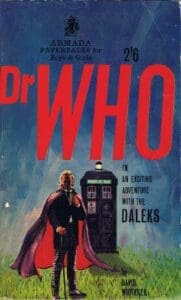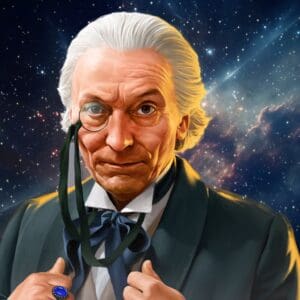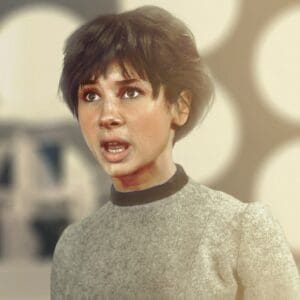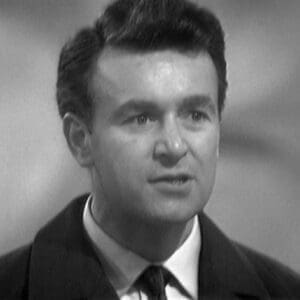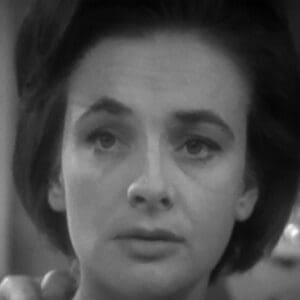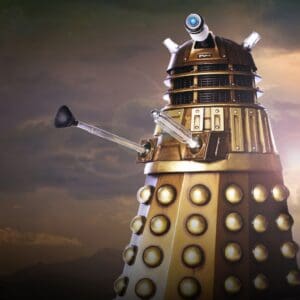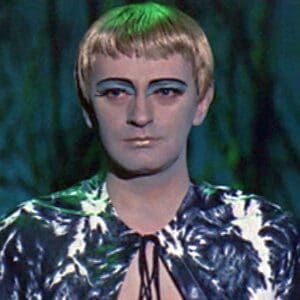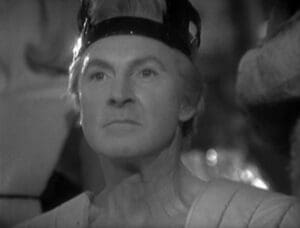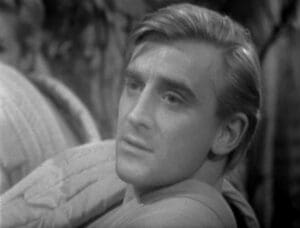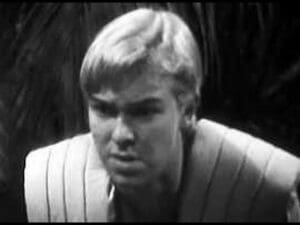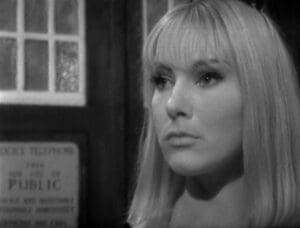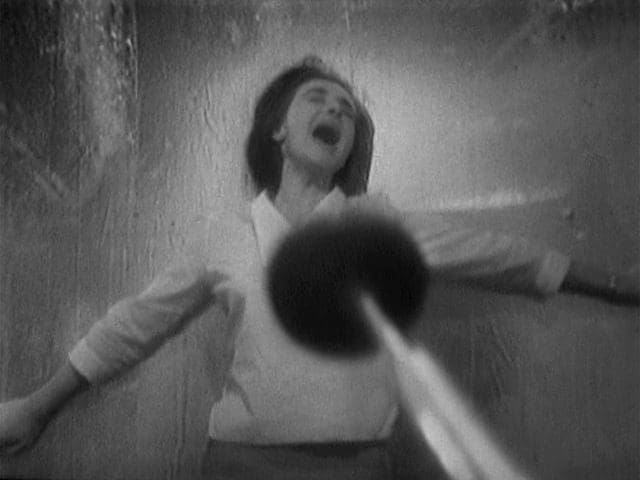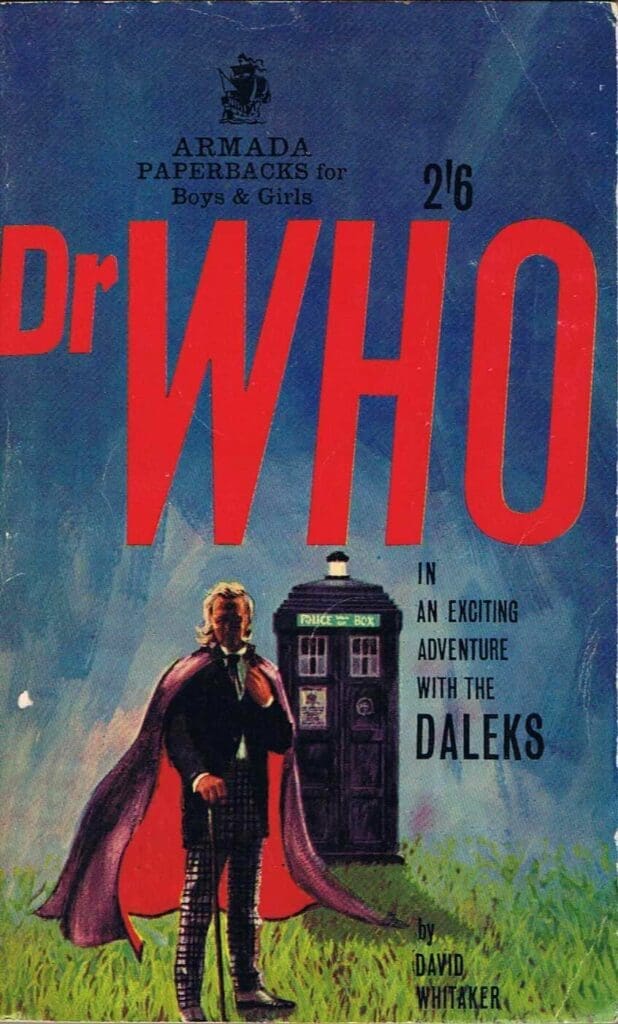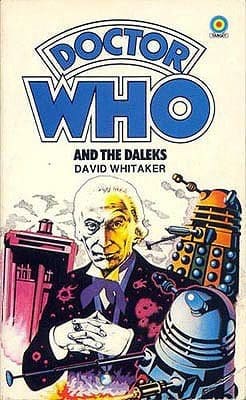
Target Collection
Doctor Who and the Daleks
Sets:
Target Collection
Reviews and links from the Community
Review of Doctor Who and the Daleks by Rock_Angel
Wow didn’t expect this to be as good as it was it’s like a mix of unearthly child and daleks and it works so well honestly better then both stories
Review of Doctor Who and the Daleks by WHOXLEY
Once upon a time…
Context for novelisation
- Doctor Who in an Exciting Adventure with the Daleks (if you’re boring, it’s Doctor Who and the Daleks) serves as the very first Doctor Who novelisation. And it’s an interesting little oddity. In many ways, this novelisation can be seen as an alternate beginning for Doctor Who as a whole. Whilst also acting as a condensed version of the iconic original Dalek story. Being the first ever novelisation, David Whitaker decides to play fast and loose with DW canon and decides to give us a completely new version of Doctor Who's first story that then transitions into a retelling of Doctor Who's second story. So where better to start, than at the beginning...
Chapter One - A Meeting on the Common
- The first chapter of Doctor Who in an Exciting Adventure with the Daleks (or if you’re boring, it’s abbreviated title of DWIAEAWTD) is perhaps the book’s most iconic part. Clocking in at sixteen pages, we effectively get a completely new introduction to Ian, Barbara, Susan, the Doctor and the TARDIS.
- Unlike many other DW novelisations, this is written from Ian’s first-person perspective. And in this version, Ian is a disgruntled science teacher who, at Barnes Common at 9 o’clock at night, discovers the wreckage of a car crash. There he meets Barbara, a secretary turned tutor who was driving one of her students, Susan, home. When they got hit by a lorry driver, Rest in peace, unnamed lorry driver. Upon stumbling from the wreckage, Barbara asks Ian to help her find Susan. Instead, they find the mysterious Doctor, who eventually and unwittingly leads them to his home; a blue police box. Ian and Barbara force entry, only to find the ship bigger on the inside. Before they both faints, he hears the Doctor and Susan discuss their new arrivals. Lamenting that they'll just have to take them with them…
- Chapter One is one of those pieces of Doctor Who PROSE that I can just read again and again. The setting is so well realised, the language so descriptive and the characters so interesting to follow. While the original Episode One of An Unearthly Child will always be iconic, this version offers a much more eerie and mysterious version. While reading, I constantly envisioned a foggy landscape in pitch darkness. With an ominous but inviting shape of a police box off in the distance.
Characters and Characterisation
- In Doctor Who in an Exciting Adventure with the Daleks (or if you’re boring, Doctor Who and the Daleks - David Whitaker - Introduction by Neil Gaiman) Ian acts as our main character for this adventure, far more than the titular Doctor himself. While most of his dialogue is lifted from the original two episodes, this Ian does act quite differently from his iconic TV counterpart. Ian is far more quick tempered and aggressive in this novel. Quick to snap back and argue with other characters, namely the titular Doctor himself. I don’t dislike this new Ian by any means, but I can’t exactly envision William Russell either. In Big Finish, Ian is sometimes played by Jamie Glover, and that’s the voice I hear for this Ian. Far deeper and far more, for lack of a better word; butch.
- Barbara’s character is mostly unchanged in terms of personality. Though out of her depth, she’d far more accepting of the TARDIS and the situation than Ian is at first. Around the middle though, Barbara gains a more cynical and snarky side, largely due to her frustration with the situation and her growing romantic feelings for Ian. I do quite like Barbara’s frustration in the middle as it makes her feel more real. She starts off accepting the situation of being whisked away in time and space. But as the novel goes on, you see that she’s just bottling up her emotions about everything before snapping at Ian. She’s not just a blank female lead who goes along with everything because she has no character; she does so not to worry anyone before getting exhausted and letting it all out. I’m not quite a big fan of the romance angle though. Don’t get me wrong, I love Ian and Barbara as a couple. I ship it. But in the context of this novel, she’s known Ian for at most two days. And in the final chapter she has a “I can’t hide the way I feel about him” scene with another Thal. Maybe I’m just ignorant about how women fall in love. Or maybe David Whitaker is, who knows.
- Susan is perhaps the least changed in this novel. The most changed is her surname no longer being Susan Foreman but Susan English. Very inconspicuous. She does still get her moment to shine by trekking through the forest to retrieve the anti-radiation
glovesdrugs. Though it’s less of a big moment to due an issue I’ll talk about with the Daleks. Other than that, like in the original, Susan just unfortunately doesn’t get a lot to do. - The Doctor is equally barely changed, keeping his origins vague and aura still mysterious. He’s still a bit untrustworthy, but considerably less untrustworthy. By the end of the novel, you get the feeling he has softened a bit and genuinely cares about his new travelling companions. One nice change occurs in Chapter Four. In the original story, the Doctor confesses to both Susan and Ian that he lied about needing mercury for the fluid link. Both characters are angry at the Doctor, with Ian refusing to give the fluid link back until they find Barbara. In this version, Susan leaves the room and the Doctor confesses, almost apologetically to Ian. Whilst thanking him for not revealing it in front of Susan and promising to get them home. It’s a nice scene and makes this Doctor feel more welcoming than his television counterpart. It’s a weird fusion of Season One Hartnell and Peter Cushing’s Dr. Who.
The Titular Exciting Adventure with the titular Daleks
- But in Doctor Who in an Exciting Adventure with the Daleks (or if you live in a backwards world, Skelad Eht Dna Ohw Rotcod) we’re all here for one thing. Chances are, if I read this as a child, I’d be breezing through the book until we get to the tyrannical pepper pots themselves. And they too get some interesting additions. For starters, we get a great horrifying description of what the mutant inside the casing actually looks like. You have to remember that this was around the time of the TV Century comics and everyone just assumed the Kaleds were humanoid aliens. As a result, the mutants are far more humanoid in shape. But their features, I shan’t spoil. Namely because it’s so linked to this book’s other iconic scene. This book also features the very first Glass Dalek, almost acting as the Supreme. It’s only around for the final chapter, but it's a cool scene when it shows up. David Whitaker also probably took a look at his own title for Chapter Four and thought “Ooh, that’d be a good title for a Dalek story someday”. The great illustrations also probably provided kids in the sixties with a screen-accurate look at the Daleks too. Chances are if you’ve seen any Dalek-mania merch from the time; you know that people got the Dalek design a bit wrong sometimes.
- However, I’d be lying if I said the Daleks are probably the weakest part of this novel. Namely due in part to Ian’s first-person narration. Shockingly, Ian is not involved in every single scene in the original story. This means that many scenes in the original are either cut or have to be hastily exposited to Ian after they happen. Susan’s trek through the dead forest is hastily retold to him after they’ve been given the anti-radiation
glovesdrugs. The Daleks plan to trap the Thals is hastily retold to him after Susan delivers the letter. The death of that one Thal I can’t be bothered looking up the name for by the swamp is hastily retold to him after he dies. The Doctor and Susan getting captured during the climax hastily retold to him after the Doctor and Susan are captured by another Thal I can’t be bothered looking up the name for. And perhaps most harmfully, so many iconic scenes with the Daleks by themselves are completely cut. Meaning that the titular Daleks are barely involved in the titular exciting adventure. We meet them in Chapter Four, escape from them in Chapter Six, and then don’t see them again until Chapter Nine. Bearing in mind this book is ten chapters long, and the Daleks have unfortunately nearly no presence in their own novel.
Conclusion
- Despite that negative bit at the end, I don’t hate Doctor Who in an Exciting Adventure with the Daleks at all. It’s such a charming little novel in the history of Doctor Who and infinitely rereadable. A part of me even prefers this to the original story due to its condensing of the original's weakest elements. Except for the infamous cave part. That bit always sucks no matter what version of The Daleks you’re experiencing.
- Speaking of which, did you know there's five ways of experiencing The Daleks? There's the original serial, then the original serial in colour, then the Peter Cushing film, then this novelisation, and then another illustrated version of this novelisation. Take your pick.
- I would wholeheartedly recommend Doctor Who in an Exciting Adventure with the Daleks to anyone. It’s only 162 pages long and acts as a new way to experience one of Doctor Who’s most iconic adventures.
- “Now read this book. Visit another world.”
This review contains spoilers
Review of Doctor Who and the Daleks by IceAgeComing
The first Doctor Who novelisation is one of the more interesting ones - as it diverges significantly from the originally published version of the story. David Whittacker - the original script editor for Doctor Who who remained involved with the show as a writer until 1970 (and was novelising one of his stories when he died in 1980) was tasked with both adapting Terry Nation's script for the Daleks and also introducing the main cast - Doctor Who was still new and so it was clearly felt that they clearly could not just assume readers knew who the Doctor, Ian, Barbara and Susan were.
The opening is a dramatically different retelling of An Unearthly Child - involving Ian (a teacher, but wanting to leave the profession to go into science) driving home from a failed job interview through Barnes Common when he comes across a car accident where Barbara is injured; but worried about Susan who she is tutoring. When searching they come across the TARDIS and have a very similar argument as in the broadcast story in Totter's lane before being whisked off to Skaro. This creates a dynamic that is very different to the broadcast story - rather than it being Ian+Barbara vs The Doctor with Susan being stuck in the middle; you have four relative strangers thrown together with a different dynamic. The story is also told in a first person perspective from Ian - which I think is beneficial as it allows the story to focus on these dynamics and Ian's wider thoughts - including interestingly the first indication of a romantic element to Ian and Barbara's relationship in an official publication. Its also interesting how elements of this has leaked into other elements of the expanded universe - reference to the everlasting matches is an explicit reference to this novel and makes it more important.
From there the story is a lot closer to the broadcast story until the climax although adding additional details at points. This being from Ian's perspective also shifts some emphasises - the first episode cliffhanger is mentioned by Barbara after the fact; the Doctors role in much of the second half is limited to summaries. It also means that certain characters have heightened importance - Kristas for example is a much more important, fleshed out character in this version of the story rather than the broadcast version as the story of infiltrating the city is fleshed out. The climax however is when the age of the novelisation is revealed - the use of a Glass Dalek 20 years before Revelation of the Daleks is interesting (and possibly an inspiration) but the description of the Dalek mutant itself is obviously incredibly different to a modern version. I don't think this is necessarily bad - in fact it makes this much more interesting that a more rote novelisation would be.
I think this is well worth a read - the fleshed out charactarisations are interesting; and I really like the third person perspective. This is not universally positive - things like the failure to break out of the cell initially and the boxing match scene feel like padding rather than actually building on the story - but I think Whittacker's writing on this is very interesting and compelling - especially when coupled with William Russell's performance in the associated audiobook. If you want your novelisations to align with the broadcast episode then you might not like this; but I thought this was a fun read.
Podcasts
Community Ratings
(Updates coming soon:)
Add the last X members who rated it here
Add number of Favs, and who they are, here
